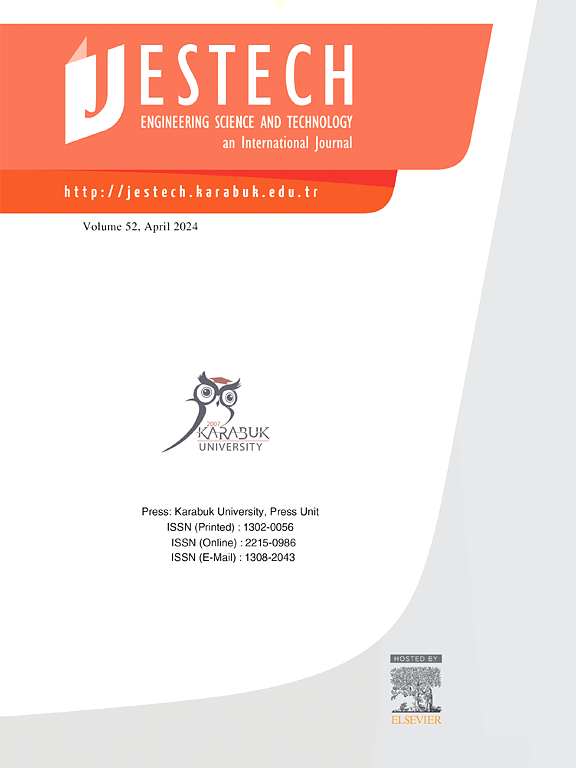A greedy approach to solve maximum independent set problem: Differential Malatya independent set algorithm
IF 5.1
2区 工程技术
Q1 ENGINEERING, MULTIDISCIPLINARY
Engineering Science and Technology-An International Journal-Jestech
Pub Date : 2025-02-12
DOI:10.1016/j.jestch.2025.101995
引用次数: 0
Abstract
In this study, a method has been developed for solving the maximum independent set problem, which is one of the significant problems in graph theory. The maximum independent set problem is NP-hard for all types of graphs. The proposed method features a robust and greedy approach that produces results in polynomial time for all graph types. The proposed method is named the Differential Malatya Independent Set Algorithm (DMISA). The presented method also provides solutions to the minimum vertex cover and maximum clique problems, which are directly related to the independent set. The DMISA algorithm consists of two sub-algorithms. The first algorithm is the Differential Malatya Centrality Algorithm (DMCA), a centrality algorithm that calculates centrality values, providing prioritization in the selection of independent members. The second algorithm uses the DMCA value to select the independent set and vertex cover members in the graphs. In this study, the DMISA analytical proof has been applied to graphs with known solutions that can be solved in polynomial time. To emphasize the success of the algorithm, test operations have been conducted on various types of graphs. The conducted tests included 40 lattices, 40 bipartite, 24 multipartite, 32 social, and random graphs. The analysis results showed that DMISA produced optimal results in lattice, bipartite, and complete multipartite graphs, while it produced generally non-optimal results for randomly generated and social graphs. Additionally, DMISA is compared with MIS methods in popular graph libraries and 7 different MIS methods. In summary, DMISA produces a larger solution than standard greedy algorithms in experiments.
求助全文
约1分钟内获得全文
求助全文
来源期刊

Engineering Science and Technology-An International Journal-Jestech
Materials Science-Electronic, Optical and Magnetic Materials
CiteScore
11.20
自引率
3.50%
发文量
153
审稿时长
22 days
期刊介绍:
Engineering Science and Technology, an International Journal (JESTECH) (formerly Technology), a peer-reviewed quarterly engineering journal, publishes both theoretical and experimental high quality papers of permanent interest, not previously published in journals, in the field of engineering and applied science which aims to promote the theory and practice of technology and engineering. In addition to peer-reviewed original research papers, the Editorial Board welcomes original research reports, state-of-the-art reviews and communications in the broadly defined field of engineering science and technology.
The scope of JESTECH includes a wide spectrum of subjects including:
-Electrical/Electronics and Computer Engineering (Biomedical Engineering and Instrumentation; Coding, Cryptography, and Information Protection; Communications, Networks, Mobile Computing and Distributed Systems; Compilers and Operating Systems; Computer Architecture, Parallel Processing, and Dependability; Computer Vision and Robotics; Control Theory; Electromagnetic Waves, Microwave Techniques and Antennas; Embedded Systems; Integrated Circuits, VLSI Design, Testing, and CAD; Microelectromechanical Systems; Microelectronics, and Electronic Devices and Circuits; Power, Energy and Energy Conversion Systems; Signal, Image, and Speech Processing)
-Mechanical and Civil Engineering (Automotive Technologies; Biomechanics; Construction Materials; Design and Manufacturing; Dynamics and Control; Energy Generation, Utilization, Conversion, and Storage; Fluid Mechanics and Hydraulics; Heat and Mass Transfer; Micro-Nano Sciences; Renewable and Sustainable Energy Technologies; Robotics and Mechatronics; Solid Mechanics and Structure; Thermal Sciences)
-Metallurgical and Materials Engineering (Advanced Materials Science; Biomaterials; Ceramic and Inorgnanic Materials; Electronic-Magnetic Materials; Energy and Environment; Materials Characterizastion; Metallurgy; Polymers and Nanocomposites)
 求助内容:
求助内容: 应助结果提醒方式:
应助结果提醒方式:


